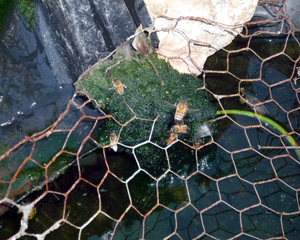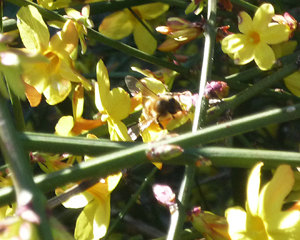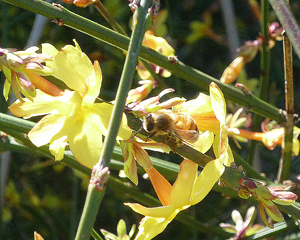 This has been the Spring of Urban Beekeeping Promotion, and it seems to me that this photo might be the single most helpful thing I could show or tell to city beekeepers. Bees need to bring water back to their hives, especially during warm weather, and bees who wander into neighbors' yards to do so can inadvertently become the authors of their own demise. In Howard County, not far from here, a major zoning smack down started because a permanently (unsway-ably! steadfastly!) terrified man noticed bees were grabbing water from the air conditioner offtake in his back yard. No stinging required, just a few thirsty bees.
This has been the Spring of Urban Beekeeping Promotion, and it seems to me that this photo might be the single most helpful thing I could show or tell to city beekeepers. Bees need to bring water back to their hives, especially during warm weather, and bees who wander into neighbors' yards to do so can inadvertently become the authors of their own demise. In Howard County, not far from here, a major zoning smack down started because a permanently (unsway-ably! steadfastly!) terrified man noticed bees were grabbing water from the air conditioner offtake in his back yard. No stinging required, just a few thirsty bees.This picture shows you the dirty truth about bees: they like their water green and murky, and that dribbly air conditioner vent probably looked like heaven to them. This is a photo from a little water fall I built into a tiny fish pond in my front yard. It holds about 50 gallons and 4 fish: this would be the same size you would get with half a whiskey barrel, or any one of a number of pre-made plastic forms. The theory is that bees get trace nutrients with the algae and muck, and I can believe that, but I also think the biologically processed water may have less of the junk that we like to put in it. Urban beekeepers, do this: before your bees ever arrive, set up a bird bath, or a pot with a bit of water and some rocks in it, and let green things happen. Moving water is better for avoiding mosquitoes, but one little permanently moist and mushy place does not create a human health hazard, and if it is there before your bees are, just about everyone will thank you.
 On other fronts, I would like to say that I still look after 9 survivor hives, but I don't call this season a success until April 1, when just about any decent laying queen and a few thousand workers can make it around here. The bees are flying from all the hives, some seem to be prioritizing nectar, and some are all about pollen. This, of course, worries me, since worrying is what I can do between the limited feedings some of them seem to need.
On other fronts, I would like to say that I still look after 9 survivor hives, but I don't call this season a success until April 1, when just about any decent laying queen and a few thousand workers can make it around here. The bees are flying from all the hives, some seem to be prioritizing nectar, and some are all about pollen. This, of course, worries me, since worrying is what I can do between the limited feedings some of them seem to need.These bees are going to forsythia, which we are taught is NOT a bee forage plant, because the long fluted neck of the blooms is too long for honeybee tongues. Today, however, as the first round of flowers is getting loose and floppy, I saw bees digging in from around the sides. Some were still learning that going into the front did not work.
 At first, I thought they might be foraging propolis from the buds, or that they might just be desperately trying to find any food at all, but on close inspection, I can see those little red tongues finding nectar after all.
At first, I thought they might be foraging propolis from the buds, or that they might just be desperately trying to find any food at all, but on close inspection, I can see those little red tongues finding nectar after all.The bees are definitely on the now-open maples, though it seems that many buds were damaged by the difficult winter. I am still looking forward to dandelion, and the full-on nectar flow they predict around here.
Two seasons are closing for me, and you could say two new ones are opening. I've spent the past month talking-talking-talking to classes and clubs and just about anyone, building the ranks of beekeepers and their supporters, trying to create a public that does not fear harmless honeybees who simply need a drink. But I would very much like to be a solo beekeeper, back to me and the bees and the wandering thoughts. The season ahead has fewer talks but lots more mentoring, and yet another round of splits and sharing and swarm control. While I have worked hard for a harvest of new beekeepers, I am pining most for those quiet days with the bees that may finally be at hand.